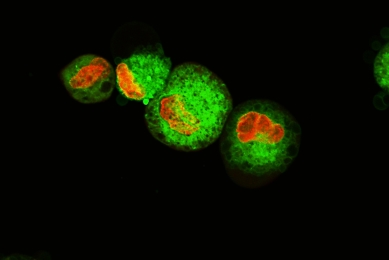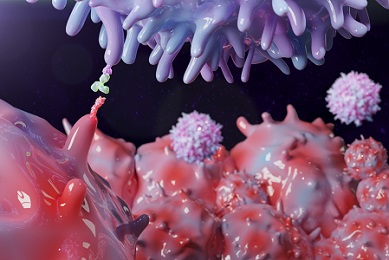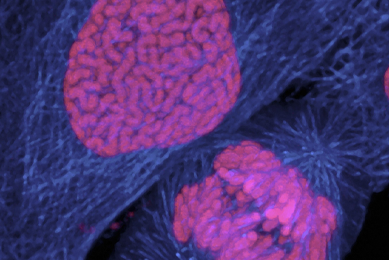Why it’s important
Chimeric antigen receptor T cell therapy (CAR-T cell therapy) is a groundbreaking treatment for cancer. Cancer patients are treated with their own T cells, which have been engineered to express a receptor that targets the T cells to antigens expressed on the surface of cancer cells. The engineered T cells then trigger lysis of the targeted cancer cells. To date, six CAR-T cell therapeutics have been approved by the FDA and are used to treat relapsed and/or refractory multiple myeloma and B cell malignancies.1 To improve the efficacy of this therapy and expand the number of treatable cancers, reliable ex vivo assays are required to test the targeting ability and killing efficiency of the engineered T cells.
Challenges
Ex vivo assays exist for assessing cytotoxicity of CAR-T cells, but each assay has limitations. For example, the chromium release assay, where cells are labeled with a radioactive isotope, is considered the gold standard cytotoxicity assay.2 Cells release the isotope upon lysis and the levels of radioactivity detected in the media correlate with the amount of cell death.3 However, this assay requires the use of a radioactive isotope, which introduces disposal and personnel safety concerns. Another commonly used cytotoxicity assay, the impedance-based assay, detects changes in electrical resistance in the co-culture as cells die and release from the cell culture plate. 4 However, this assay is limited to the analysis of adherent cell lines, and change in electrical resistance is an indirect readout of cell death.2
What’s the solution?
The ideal cytotoxicity assay should be versatile across many different target and effector cell types, and the readout for cytotoxicity should be sensitive and correlate well with the amount of cell lysis. In addition, cells used in the assay should be physiologically relevant to the cancer under study.
How we can help
To address the need for a high-throughput, sensitive, and reliable ex vivo assay for CAR-T cell therapy research, we engineered ATCC-authenticated cancer cell lines that naturally express high levels of CAR-T target antigens to express a luciferase reporter gene. Luciferase levels in the reporter lines can be easily measured using a commercially available enzymatic assay and a luminescence plate reader. When the luciferase-expressing cancer cells are co-cultured with T cells engineered to target the cancer cells, luciferase levels decrease with higher killing efficiency as the reporter cancer cells die.
In addition, we chose which lines to engineer based on their endogenously high expression of popular CAR-T therapy targets (CD19, CD20, or HER2). These cell lines are therefore physiologically relevant and are excellent models for B cell lymphomas or breast ductal carcinoma. The reporter lines have also been validated in live imaging assays, which allow researchers to observe the targeting and lysis of the reporter cells in real time. Overall, using these CAR-T target reporter lines, researchers can combine real-time imaging data with the quantitative sensitivity of the luciferase assay. These features improve the accuracy and ease of the cytotoxicity assay and will help researchers expand CAR-T cell therapy applications and improve CAR-T targeting efficacy.
Table 1: CAR-T Target Luciferase Reporter Cells
| Designation | ATCC® No. | Disease | Target |
| WIL2-S-Luc2 | CRL-8885-LUC2™ | B Cell Lymphoma | CD19 |
| Raji-Luc2 | CCL-86-LUC2™ | Burkitt’s Lymphoma | CD19 |
| Daudi-Luc2 | CCL-213-LUC2™ | Burkitt’s Lymphoma | CD20 |
| Farage-Luc2 | CRL-2630-LUC2™ | Non-Hodgkin’s B Cell Lymphoma | CD20 |
| BT-474-Luc2 | HTB-20-LUC2™ | Breast Ductal Carcinoma | HER2 |
Did you know?
To help facilitate immuno-oncology studies and immunotherapy development, ATCC offers a variety of reporter-labeled cell models including checkpoint luciferase reporter cells, CAR-T target luciferase reporter cells, and THP-1 reporter cells.
Meet the authors
Catherine McManus, PhD
Scientist, Immuno-oncology, ATCC
Catherine McManus, PhD, is a Scientist in the Immuno-Oncology group in Cell Biology R&D at ATCC. Prior to joining ATCC, Dr. McManus received her PhD in Genetics from Yale University and completed her postdoctoral training at NIH. She has expertise in engineering reporter constructs for use in and ex vivo, identifying reporter construct integration sites, and assaying reporter expression.
John Foulke, MS
Lead Biologist, ATCC
John Foulke is a Lead Biologist in the Immuno-Oncology group in the R&D department at ATCC. John joined the ATCC cell biology R&D group in 2008, and he has led many projects centered on the development of novel cell lines and cell-based reporter systems to support cancer research community. His work is mainly focused on developing innovative cell models for research and drug discovery in the immuno-oncology field.
Explore our featured resources

CAR-T Target Luciferase Reporter Cells
ATCC generated luciferase reporter solid and liquid tumor cell lines that express tumor antigens such as CD19, CD20, and HER2. Learn how you can incorporate these target cells into your T-Cell cytotoxicity assays to enable your breakthroughs in immuno-oncology.
More
Immuno-oncology
To support immuno-oncology research, ATCC provides a large collection of fully characterized and authenticated cell lines, human primary cells, and advanced cell models.
More
Cancer Research
Fighting cancer requires painstaking research and development. Scientists need materials and standards for drug screening, tumor mechanisms, cancer immunology, and cancer diagnostics. ATCC has research models such as organoids, conditionally reprogrammed cells, luciferase expressing reporter cell lines, isogenic CRISPR/Cas9 genome-edited cell lines, and epithelial-mesenchymal transition reporter cell lines.
MoreReferences
- Cappell KM, Kochenderfer JN. Long-term outcomes following CAR T cell therapy: what we know so far. Nat Rev Clin Oncol 20(6): 359-371, 2023. PubMed: 37055515
- Kiesgen S, et al. Comparative analysis of assays to measure CAR T-cell-mediated cytotoxicity. Nat Protoc 16(3): 1331-1342, 2021. PubMed: 33589826
- Brunner KT, et al. Quantitative assay of the lytic action of immune lymphoid cells on 51-Cr-labelled allogeneic target cells in vitro; inhibition by isoantibody and by drugs. Immunology 14(2):181-196, 1968. PubMed: 4966657
- Peper JK, et al. An impedance-based cytotoxicity assay for real-time and label-free assessment of T-cell-mediated killing of adherent cells. J Immunol Methods 405:192-198, 2014. PubMed: 24486140